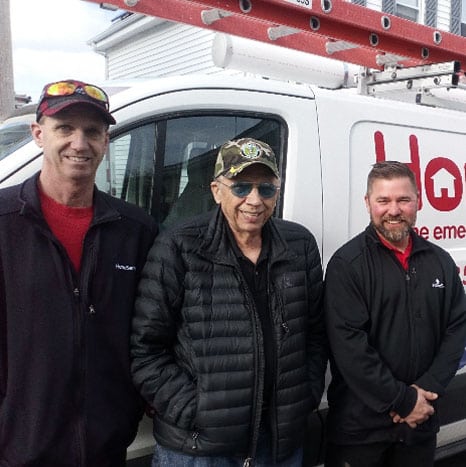Veterans bring a lot to the table, and many of the skills they learned in the armed forces can benefit your community once they’ve been discharged. Many times, a veteran just needs a helping hand, like Edward Andruskieicz, of Lynn, Massachusetts.
 Edward, an 87-year-old World War II veteran, saw several feet of flood waters invade his home during the record-setting January storms. The water ruined his boiler at the same time record low temperatures struck the area. However, a national company – Utility Service Partners, a HomeServe company – stepped in and replaced his boiler at no cost.
Edward, an 87-year-old World War II veteran, saw several feet of flood waters invade his home during the record-setting January storms. The water ruined his boiler at the same time record low temperatures struck the area. However, a national company – Utility Service Partners, a HomeServe company – stepped in and replaced his boiler at no cost.
While veterans bring unique skills, they also have unique hurdles, including higher than national average rates of unemployment, homelessness and suicide, but with the help of their communities, they can overcome them. Like Edward, many need a helping hand at the right time – especially offered by the people, organizations and businesses in their communities.
Veteran unemployment is twice the national average. Veterans’ biggest obstacles in obtaining employment are translating their military background into work experience easily understandable by civilians, meeting licensing requirements and finding employment while disabled.
The older a veteran is and the longer he or she has been separated from military service, the better their prospects are for employment. Enlisting immediately following high school means much of a recently separated veteran’s networking opportunities and skills training have taken place in the military.
While 80 percent of military jobs have a civilian counterpart, licensing requirements can differ. They may require a veteran to go through civilian education in a field they have already mastered. In addition, the educational and testing requirements may vary from state to state. The Veterans Administration will pay for testing, but the cost of education – even if it goes over the same ground veterans covered in their military training – falls on the veteran.
Disability rates are higher among veterans; about 29 percent of recent veterans have some sort of service-related disability. Most common are missing limbs, burns, spinal cord injuries, post-traumatic stress disorder, hearing loss and traumatic brain injuries. Veterans with service-connected disabilities had an employment-population ratio of 43.3 percent, lower than the ratio for those veterans without a disability at 49 percent.
The VA provides a Military Skills Translator, which translates military jobs into resume-ready information – and imports it to the organization’s Resume Builder. Additionally, there are special unemployment benefits for ex-service members. Those who were discharged honorably from active duty can apply in their state of residence.
In partnership with the Department of Labor, the VA offers Vocational Rehabilitation and Employment services, which helps with training for new job skills, starting a business or receiving educational counseling. The Veterans Opportunity to Work program can extend those vocational rehabilitation benefits for those who have completed the initial program and qualify.
RallyPoint provides post-military professional networking opportunities for veterans, and Jobless Warrior provides employment and job search resources, including career coaches and information on employers looking to hire veterans.
Those veterans with service-connected disabilities have preference when applying for certain federal jobs or winning federal government contacts. Disabled veterans also are eligible for Vocational Rehabilitation. Those who hire service-disabled veterans qualify for tax incentives through the Special Employer Incentive program. The VOW program also can assist veterans in receiving disability accommodations.
Veteran Homelessness
One in ten of those who are homeless are veterans, 50 percent are disabled and three-quarters of homeless veterans have mental health issues. Another 1.4 million veterans are at-risk for homelessness, because of poverty, lack of support networks and overcrowded housing. Half a million veterans pay more than half of their income in rent.
Many veterans who are homeless or at-risk for homelessness have service-connected disabilities, especially PSTD, or substance abuse issues. Unemployment because of the inability to transition military training to civilian work also factors in.
The National Coalition for Homeless Veterans stresses the need for housing, nutrition, physical and mental healthcare and job services for homeless and at-risk veterans. The coalition reports that community-based programs with veterans serving veterans saw the greatest success rate.
The Interagency Council on Homelessness has established a benchmark guide for communities looking to actively address veteran homelessness. The council also has published a strategy guide, recommending public commitment to eradicating veteran homelessness; coordination between programs and with private landlords to match homeless vets with housing; identifying available resources on the federal, state and local levels; and coordinating with job assistance programs to provide training and services.
In April, the Department of Labor’s Veterans Employment and Training Service announced million available in grant funding to provide veterans with job training to transition them from homelessness to sustainable housing.
The VA provides housing assistance in conjunction with Housing and Urban Development; the Health Care for Homeless Veterans program, which includes exams, treatment and referrals; Domiciliary Care for Homeless Veterans program, which offers mental health and rehabilitation services; and job services targeted specifically toward homeless veterans.
Veterans Matter is a nonprofit organization that provides housing to homeless veterans and was founded by a formerly homeless man. Veterans Matter works directly with organizations to raise awareness and funding.
Veteran Suicide
Veterans represent one in five of all those who die of suicide in America. Twenty veterans die of suicide daily. Many of those either lack access to or don’t utilize available VA services.
Veterans who suffer from isolation, with little to no meaningful social connections, are particularly prone to suicide, especially during transitional periods – such as separation from the military, according to a University of Southern California study. Unemployment and homelessness — periods when veterans may see themselves as burdens to their communities – are significant stressors, the study found. The risk of suicide is greatest during the first three years after separation.
This isolation or loneliness can be especially acute in veterans who suffer from PSTD or were prisoners of war, even if they have an adequate support system. In such cases, veterans may feel that it is impossible for others to understand the trauma they’ve endured, even while yearning for that understanding, causing a feeling of disconnection.
Prevention measures recommended in a Veterans Health Administration report include outreach; focusing on gun and medication safety; focusing on those with a higher risk, including young men aged 18 to 25, women and those who had prior mental health conditions and made prior suicide attempts; and offering skill building to prevent stressors such as unemployment and homelessness.
A Center for Disease Control report on suicide prevention includes recommendations such as strengthening financial security, stabilizing housing, increasing access to mental health care, improving safe storage practices for firearms and medicines, promoting community engagement, strengthening communication and problem-solving skills, encouraging emotional intelligence and identifying and intervening with those most at-risk.
The VA has a dedicated crisis line – call 1(800) 273-8255 or text 838255 – including resources for veterans and concerned loved ones, information on suicide warning signs and crisis resources.
The VA Office of Mental Health and Suicide Prevention has developed “Signs, Ask, Validate, Encourage and Expedite” training to help those who encounter veterans to recognize suicide red flags and act. The training is available in partnership with the nonprofit PsychArmor Institute and covers a variety of subjects from military culture and myths to supporting veterans and self-care.
The VA Strategy for Preventing Veteran Suicide addresses veteran suicide in a multi-pronged approach: visibility and awareness; preventive services; treatment and support; and research. At the heart of it – at the heart of all efforts to address major issues impacting veterans – is a community-based approach that puts those professionals and organizations, the “boots on the ground,” at the front lines in providing care and services.
Through awareness, pro-active and preventive measures and support, your community can best serve its veterans, reaping the benefits of all they have to offer in return and thanking them for their service. Learn more about how NLC member cities and private industry are working together to tackle these issues.
HomeServe administers the National League of Cities Service Line Warranty Program, offering education on homeowners’ service line maintenance responsibilities and offering warranty repairs from local, licensed and vetted contractors.

